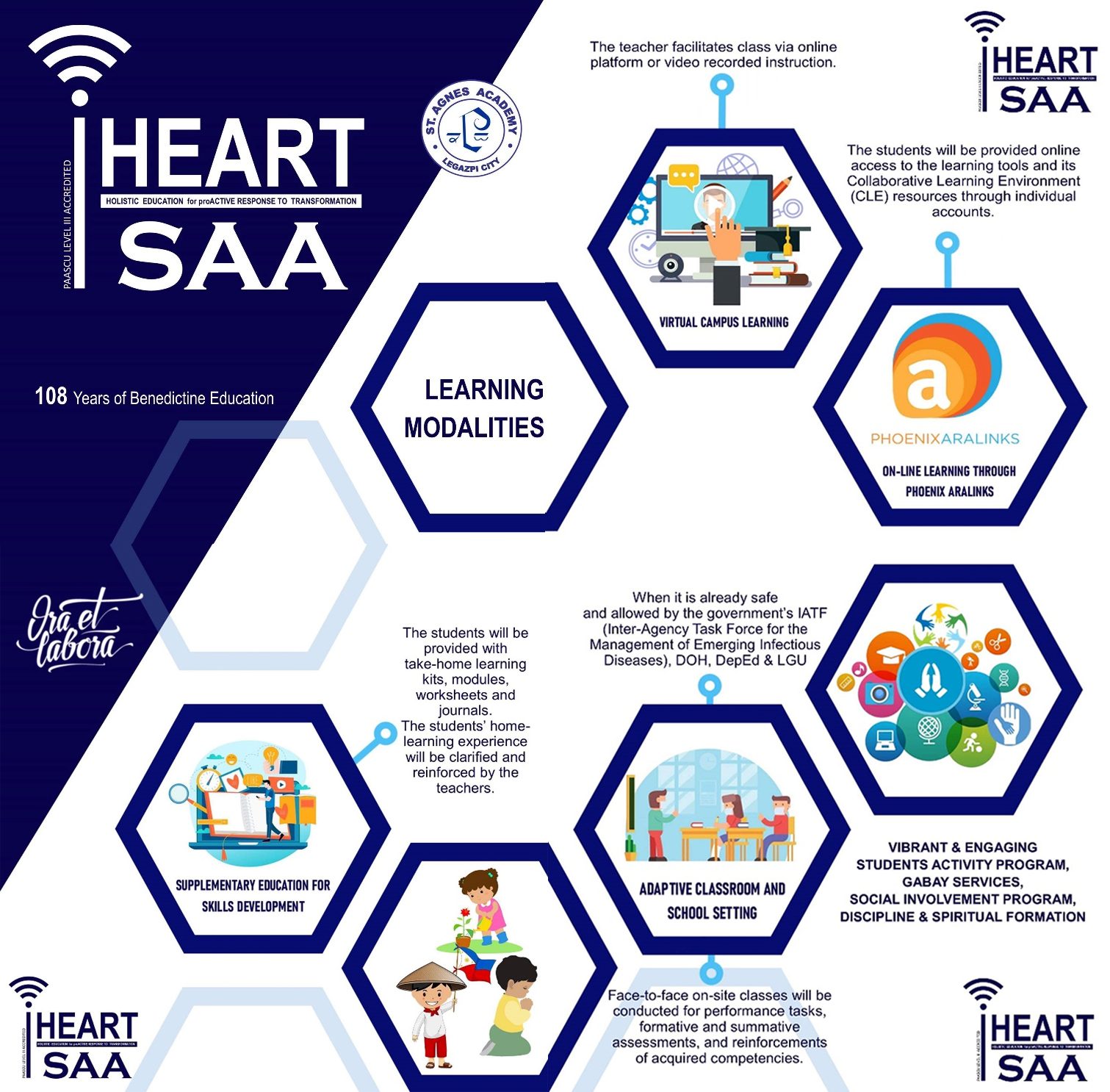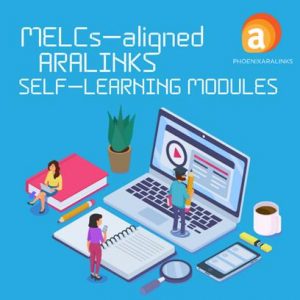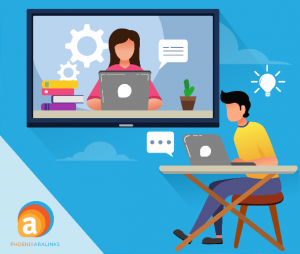This school of the Lord’s Service has been providing holistic and quality education in Albay since 1912. Hence, the drastic call for reinventing the school program posed a uniquely exciting challenge. After a series of discussions, consultations and deliberations, the Administrative and the Educational Council brings in to the Agnesian Community the Program crafted to encapsulate the Mission Vision of SAA adapting to the new normal in the educational landscape:
The HOLISTIC EDUCATION for proACTIVE RESPONSE to TRANSFORMATION
#iHEARTSAA

The Basic Education Unit (Kindergarten, Elementary, High School, Senior High School) shall navigate the teaching and learning environment through the DISTANCE/ BLENDED LEARNING APPROACH in Education.
The Enhanced K to 12 Basic Education Curriculum which the School utilizes, was refined to adapt to the Most Essential Learning Competencies ( MELCs) provided by the Department of Education. Each Learning Area across the levels streamlined the desired competencies. This is to put less pressure on the students in their new learning environment. Notwithstanding the school’s mission and vision, SAA education more vibrantly puts premium on the Catholic and Benedictine formation of the students. The Christian Living Education (CLE) and the Campus Ministry work hand in hand in the conduct of meaningful and engaging religious formation activities via alternative delivery modes. With the students’ varied interests and skills in mind, the Student Activity Program had been reinvented to accessible platforms so as to get across interesting Club Activities to the students. To further hone the students on the values and discipline which the school envision, the Student Formation Program had been revitalized and aptly redesigned.
I. LEARNING DELIVERIES
A. DISTANCE LEARNING
Use of various technologies and learning materials to facilitate instruction and student- teacher, student- student communication. This provides students with greater safety and comfort while engaging in the materials at home. These learning materials will be in the form of:
-
- Digital Learning Management System/ ARALINKS
- Online Educational Applications
- Virtual Learning Platforms
- Video- Recorded Instructions
- Modules
- Self- Learning Kits and Worksheets
- Textbook – based activities
- Inquiry Project- Based Learning Materials or Team – Based Activity Sheets
- Game- Based Learning Materials
B. BLENDED LEARNING
An approach to education that combines online educational materials and opportunities for virtual interaction with traditional onsite learning. This approach will be employed only when the government permits schools to conduct onsite classes. The school will strictly adhere to the directives of the IATF, DOH, and DepEd regarding the conduct of onsite classes. It is most beneficial especially to the Primary Levels (Pre- Kindergarten to Grade 3) who will be needing a more personalized and focused learning. In this approach, the teachers, when needed, can give real- time feedback and, learning interventions in very small groups on a certain schedule.
- FLEX MODEL AND BLENDED LEARNING
Allows students to move on fluid schedules among learning activities according to their needs. Online Learning is the backbone of student learning in a Flex model. Teachers provide support and instruction as needed while students work through coursework and content. The teachers provide face- to – face support on a flexible and adaptive as needed basis through activities such as small group instruction, group projects, and individual tutoring.
- FLIPPED MODEL
Focused on student engagement and active learning, giving the teacher a better opportunity to deal with mixed levels, student difficulties and differentiated learning preferences. The teacher will have the students interact with the new materials for homework and onsite classes is reserved for a more “ active learning” allowing the students to learn on their own pace.
C. MODALITIES AND STRATGIES
- Virtual Learning
The teacher facilitates class discussions, readings, lectures, assignments and assessments via online platforms, live sessions, and video conferencing. - Phoenix ARALINKS’ Online Distance Learning Programs
The use of varied digital authoring tools which includes Self- Learning Modules aligned to DepEd MELCs and its Collaborative Learning Environment (CLE) resources. The students are provided with online access to the learning tools through individual accounts. The teachers are available for coaching and mentoring.
-
Supplementary Education for Skills Development
Off-site School Learning particularly focusing on the provision of additional support activities for curriculum subjects including enrichment for Religious and Character Formation, Arts and Sports, Clubs and Social Involvement. (refer to the Other Learning Programs) - The students’ Home- Learning experienceare reinforced and clarified by the teachers through online individual / team conferences, ARALINKS Collaborative Learning tools.

- Face- to – Face Onsite LearningThis will NOT be employed, should there be no available vaccine for the virus yet. When the time and circumstances permit, this will be conducted for performance tasks, formative and Summative Assessments, and reinforcements of acquired competencies.
- Textbooks ,Workbooksand Magazine Subsciptions
To guide the learning of the curriculum, the students will constantly refer to the textbooks.
II. LEARNING ENVIRONMENT
A. ADAPTIVE CLASSROOM AND SCHOOL SETTING
In the event that the Department of Education and the Government would already permit the conduct of onsite classes, the School shall strictly adhere to the protocols suggested by the IATF and the DOH. The following measures will be undertaken:
- Class Size (Double Shift)
Each class / section will be clustered into 2
1.7 Sr.Pudentiana – A
7 Sr. Pudentiana – B*with utmost 15- 20 students in each class
- Schedule of Classes and Mode of Delivery of Instruction
Classes will be conducted onsite for 2 days (half day) and offsite (home) for 3 days.
- The Elementary students will take 4 subjectsand the Junior High School students will take 6/7 subjects on the First Semester and the remaining subjects on the Second Semester. The Senior High School students will have 8 subjects in every semester.
B. DIGITAL DIVIDE
SAA acknowledges the fact that digital divide is a huge limiting factor in the success of Distance Learning. Considering that learning should be made available to all Agnesian learners, the following factors are identified and considered in the design of this Program.
1. ACCESSIBILITY TO TECHNOLOGY AND LEARNING MATERIALS
To get a better picture of the students’ capabilities in the access of the Program, a survey is conducted during the online registration and enrollment. The following information are desired:
MEANS OF ACCESSING THE INTERNET
- Mobile Data
- Internet Broadband
- Pocket WiFi
- Fiber Internet Connection
- Mobile Hotspots
- None/ or go to internet shop
INTERNET CONNECTION
- Speed (very slow, slow, average , fast , very fast)
- Indicate Mbps speed of internet
DEVICES USED TO ACCESS THE NET
- Smartphone
- Laptop
- Desktop
- Netbook
- iPad
- None
The students’ capacity to indulge in online learning activities and / or the availability and reliability of online tools at home is identified so as to determine and employ the most appropriate modalities in teaching and learning. The student will be pre-grouped accordingly.
2. DISTRIBUTION AND RETRIEVAL OF LEARNING MATERIALS
This is to ensure that learning will be made accessible to all the students. Those with limited or no access to good and reliable internet connection are provided with printed instructional materials and learning kits, textbook- based activities, modules and recorded lectures. A scheme/ schedule is followed for facilitating the distribution and retrieval of the learning materials.

